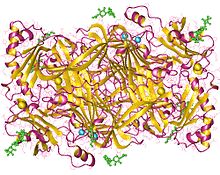Amine primaire oxydase
L'amine primaire oxydase est une oxydoréductase qui catalyse la réaction :
Amine primaire oxydase
| N° EC | EC |
|---|
| IUBMB | Entrée IUBMB |
|---|---|
| IntEnz | Vue IntEnz |
| BRENDA | Entrée BRENDA |
| KEGG | Entrée KEGG |
| MetaCyc | Voie métabolique |
| PRIAM | Profil |
| PDB | RCSB PDB PDBe PDBj PDBsum |
| GO | AmiGO / EGO |
Cette enzyme est une quinoprotéine à cuivre sensible à l'inhibition par les composés carbonylés tels que ceux de la famille de la semicarbazide H2N–NH–CO–NH2. Elle est spécifique des amines primaires et agit très peu ou pas sur les diamines telles que l'histamine ainsi que sur les amines secondaires et les amines tertiaires.
Initialement classée comme amine oxydase à cuivre (EC ) sur la base de la nature du cofacteur, l'amine primaire oxydase (EC ) en a été séparée de la diamine oxydase (EC )[2].
Notes et références
modifier- (en) E. Jakobsson, J. Nilsson, D. Ogg et G. J. Kleywegt, « Structure of human semicarbazide-sensitive amine oxidase/vascular adhesion protein-1 », Acta Crystallographica D Biolgical Crystallography, vol. D61, no Pt 11, , p. 1550-1562 (PMID 16239734, DOI 10.1107/S0907444905028805, lire en ligne)
- (en) Entrée EC 1.4.3.6 sur le site de l'IUBMB.
- (en) Haywood, G.W. and Large, P.J., « Microbial oxidation of amines. Distribution, purification and properties of two primary-amine oxidases from the yeast Candida boidinii grown on amines as sole nitrogen source », Biochem. J., vol. 199, no 1, , p. 187–201 (PMID 7337701, PMCID 1163349)
- (en) Tipping, A.J. and McPherson, M.J., « Cloning and molecular analysis of the pea seedling copper amine oxidase », J. Biol. Chem., vol. 270, no 28, , p. 16939–16946 (PMID 7622512)
- (en) Lyles, G.A., « Mammalian plasma and tissue-bound semicarbazide-sensitive amine oxidases: biochemical, pharmacological and toxicological aspects », Int. J. Biochem. Cell Biol., vol. 28, no 3, , p. 259–274 (PMID 8920635)
- (en) Wilce, M.C., Dooley, D.M., Freeman, H.C., Guss, J.M., Matsunami, H., McIntire, W.S., Ruggiero, C.E., Tanizawa, K. and Yamaguchi, H., « Crystal structures of the copper-containing amine oxidase from Arthrobacter globiformis in the holo and apo forms: implications for the biogenesis of topaquinone », Biochemistry, vol. 36, , p. 16116–16133 (PMID 9405045, DOI 10.1021/bi971797i)
- (en) Lee, Y. and Sayre, L.M., « Reaffirmation that metabolism of polyamines by bovine plasma amine oxidase occurs strictly at the primary amino termini », J. Biol. Chem., vol. 273, no 31, , p. 19490–19494 (PMID 9677370)
- (en) Houen, G., « Mammalian Cu-containing amine oxidases (CAOs): new methods of analysis, structural relationships, and possible functions », APMIS Suppl., vol. 96, , p. 1–46 (PMID 10668504)
- (en) Andrés, N., Lizcano, J.M., Rodríguez, M.J., Romera, M., Unzeta, M. and Mahy, N., « Tissue activity and cellular localization of human semicarbazide-sensitive amine oxidase », J. Histochem. Cytochem., vol. 49, no 2, , p. 209–217 (PMID 11156689)
- (en) Saysell, C.G., Tambyrajah, W.S., Murray, J.M., Wilmot, C.M., Phillips, S.E., McPherson, M.J. and Knowles, P.F., « Probing the catalytic mechanism of Escherichia coli amine oxidase using mutational variants and a reversible inhibitor as a substrate analogue », Biochem. J., vol. 365, no Pt 3, , p. 809–816 (PMID 11985492, PMCID 1222726, DOI 10.1042/BJ20011435)
- (en) O'Sullivan, J., Unzeta, M., Healy, J., O'Sullivan, M.I., Davey, G. and Tipton, K.F., « Semicarbazide-sensitive amine oxidases: enzymes with quite a lot to do », Neurotoxicology, vol. 25, nos 1-2, , p. 303–315 (PMID 14697905, DOI 10.1016/S0161-813X(03)00117-7)
- (en) Airenne, T.T., Nymalm, Y., Kidron, H., Smith, D.J., Pihlavisto, M., Salmi, M., Jalkanen, S., Johnson, M.S. and Salminen, T.A., « Crystal structure of the human vascular adhesion protein-1: unique structural features with functional implications », Protein Sci., vol. 14, no 8, , p. 1964–1974 (PMID 16046623, PMCID 2279308, DOI 10.1110/ps.051438105)

